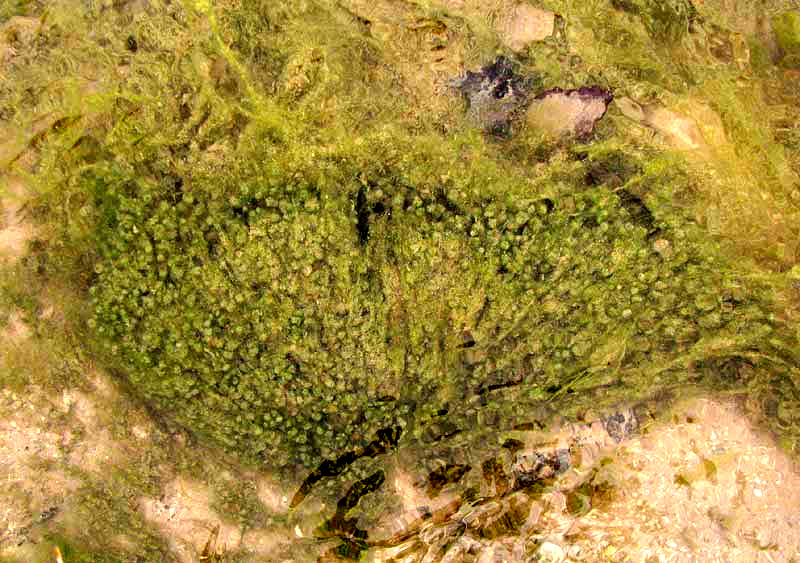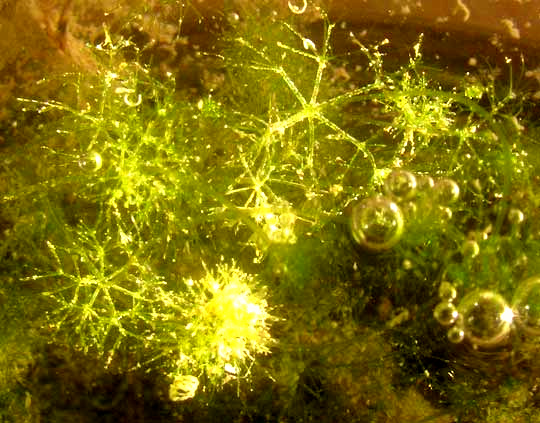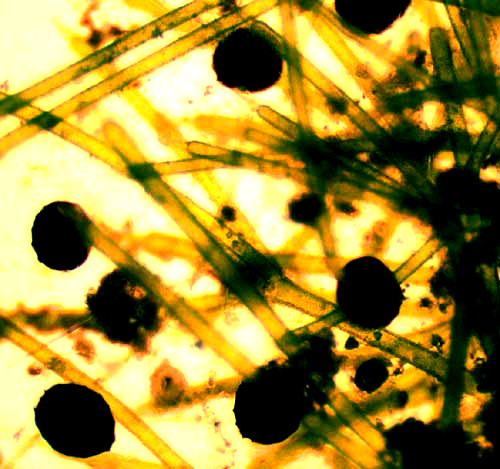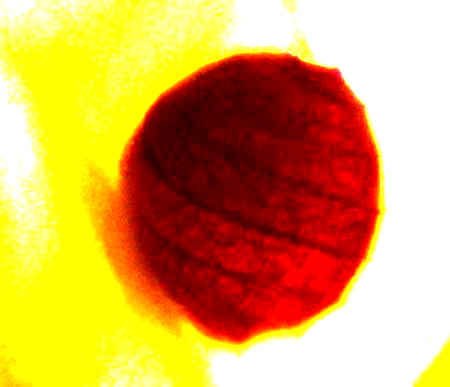Excerpts from Jim Conrad's
Naturalist Newsletter

from the December 22, 2013 Newsletter issued from the Frio Canyon Nature Education Center in the valley of the Dry Frio River in northern Uvalde County, southwestern Texas, on the southern border of the Edwards Plateau; elevation ~1750m (~5750 ft); N29.62°, W99.86°; USA
NITELLA
In some places the little Dry Frio River disappears completely into gravel banks only to reappear a little downstream issuing from a similar gravel bank. In some places, however, there's enough water to form pools in which aquatic vegetation survives year round. In such spots we've identified several aquatic flowering plants, such as pondweed and water milfoil, and several algae. This week something new turned up, and at first I wasn't sure whether it was a flowering plant or an alga. Above, you can see its pie-sized, fan-shaped colony heavily coated with calcium-rich marl mud and consisting of bean-size, spherical clusters arrayed atop one another on numerous long, pliable stems, like shish-kebabed Brussels sprouts, and directed downstream by the flow.
Even after parts had been shaken and washed to remove the marl, the pieces were so matted and disfigured that it was hard to make much of the organism's anatomy. However, after stem segments had lived in a fishbowl for a couple of weeks, new sprouts arose bearing clean, well-formed appendages. Below, you can see them amidst bubbles of freshly photosynthesized oxygen, with the camera shooting downward over the water's surface inside the fishbowl:

Seeing no traces of vessels or stem nodes, now it's apparent that instead of a flowering plant we have an alga, and remember that algae are not regarded as plants, animals or fungi. Though they photosynthesize like plants, they lack many cell organelles and cell types found in plants.
Last August, also in the Dry Frio, we found another alga with slender appendages arranged is frilly whorls along the stem. That was Chara, which you can review at https://www.backyardnature.net/n/x/chara.htm.
This plant was different from Chara in that its parts were smaller, much softer and smoother, and not covered with brittle calcium crust.
However, in the Chara Family of algae, there are different genera, and this week's find was one of them. It was a member of the genus NITELLA, which most folks just call Nitella, though sometimes they're called Stoneworts. Several species of Nitella are known and they are widely distributed, but I can't say which species this is.
Actually, Nitella and Chara have no real stems, but rather hollow, stem-like structures with forked branches along their lengths. Plant stems have water-conducting vessels, nodes and other details not found in algae such as Nitella and Chara.
In stream ecology, both Chara and Nitella often form "underwater prairies" in which many micro and macro invertebrates graze and find shelter. These invertebrates in turn are preyed on by fish, amphibians, reptiles, ducks, etc.
In evolutionary biology Chara and Nitella are interesting because current evidence suggests that about 500 million years ago the first plants probably evolved from shallow freshwater algae much like Chara and Nitella.
from the December 22, 2013 Newsletter issued from the Frio Canyon Nature Education Center in the valley of the Dry Frio River in northern Uvalde County, southwestern Texas, on the southern border of the Edwards Plateau; elevation ~1750m (~5750 ft); N29.62°, W99.86°; USA
NITELLA WITH ANTHERIDIA
Algae don't produce flowers, fruits and seeds, but nowadays our Nitella is loaded with reproductive structures that any honest student might look at and call fruits or seeds. At least call them that if seen under a dissecting scope, for they are so small that otherwise they're hardly visible. Below, you can see how crowded they are among Nitella's branches:

The dark, spherical items are the fruitlike things. In daylight they are tan colored and the Nitella stems are green. They are antheridia, which contain sperm, so they're analagous to male flowers on flowering plants. On Nitella, antheridia are more or less spherical and ornamented with various patterns that vary from species to species, and so are very important in identifying Nitella to species level. The female parts, called oogonia, contain eggs, are a little larger and are crowned with noticible rings of cells.
The species of our Nitella remains unknown, so in the hope that later someone can identify our species, I overexposed an antheridium to show its ornamentation, which is shown below:
